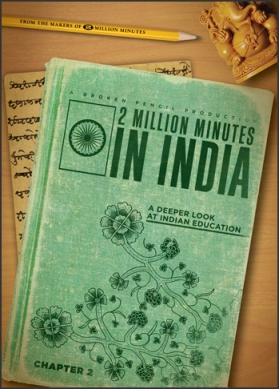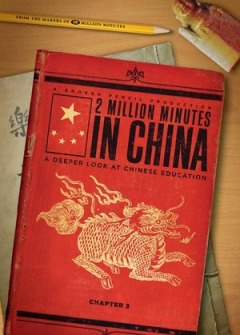First, Second and Third World Schools
 I first became aware of ED in 08 at a conference, and I wrote a post about the documentary they produced last December called Two Million Minutes.
I first became aware of ED in 08 at a conference, and I wrote a post about the documentary they produced last December called Two Million Minutes.That film compares education in the United States to that of India and China. The premise of that film is that that amount of time is the same for all (though the amount spent in school or studying varies) and will determine their economic prospects for the rest of their lives.
I was thinking about the film when I checked in on Thomas L. Friedman's blog. Friedman is headed in a new direction for his latest book, Hot Flat and Crowded. His "Geo-Greenism" is all about the Energy Technology revolution which he also sees as both transformative and disruptive. But many educators are still digesting and trying to make sense of the "flat classroom" and what it means.
The producers of that first documentary have produced several more programs since I last blogged about their work. Two Million Minutes in India is the second chapter, made one year later, and it looks at the students who have completed their freshman year of college, and brings together the two American students and the two Indian students for a roundtable discussion.
Chapter 3 is Two Million Minutes in China which follows the same format. Both of these latest films asks the students questions like:How well did high school prepare them? Do the wish they had done things differently? How do they see their peers in the other countries now? What has their first year of college been like? How different is the college experience between these two countries?
 In an interview with Dr. Lin, Headmaster of the Xiwai International School, he states that the school's mission is "to cultivate within each of its students a balance of Chinese wisdom and a global perspective." Xiwai International School is a public-private joint venture in education between Xiwai Investment Co. and Shanghai International Studies University. The former is a company specializing in education investment; it consists of shareholders and senior managers, including individuals from the international banking sector, such as Goldman Sachs, and from Chinese and overseas educational institutions. Shanghai International Studies University is one of China 's key universities, directly under the jurisdiction of the Chinese Ministry of Education.
In an interview with Dr. Lin, Headmaster of the Xiwai International School, he states that the school's mission is "to cultivate within each of its students a balance of Chinese wisdom and a global perspective." Xiwai International School is a public-private joint venture in education between Xiwai Investment Co. and Shanghai International Studies University. The former is a company specializing in education investment; it consists of shareholders and senior managers, including individuals from the international banking sector, such as Goldman Sachs, and from Chinese and overseas educational institutions. Shanghai International Studies University is one of China 's key universities, directly under the jurisdiction of the Chinese Ministry of Education.Nations with the best schools attract many of the best jobs. As jobs move from America to other countries (see The World Is Flat and countless other books, articles and blogs), our economy and the economy of our children will suffer even more than today.
- Almost 70% of America's eighth-graders do not read at grade level.
- Our 15-year-olds rank 25th in math and 21st in science.
- America showed no improvement in its post-secondary graduation rate between 2000 and 2005.
Two Million Minutes: Lesson Plan is the last in this DVD series.
It is a Call to Action, with an Action Plan.
It explores what can be done at the national, state, and local level to change our culture. It discusses how Governors, Mayors and community leaders can use Symbols, Rhetoric, Recognition and Rewards to bring cultural change to benefit our children in the 21st century.
If you or your students think American education standards are higher than the Third World, take a shot at the online Third World Challenge. Find out now if you, your students or your own children are competitive on a test to enter 11th grade in rural India.
The Strong American Schools campaign of ED in 08 addresses some of these issues of crisis in our public schools.
From their site:
Flogging U.S. schools to perform - governments threaten principals and teachers with school takeovers and job loss, the media reports and reprimands, society invests more money each year, foundations pour in additional billions, yet the result remains the same - the decline continues.
The Two Million Minutes series took a deep look into high school education in India, China and the U.S. and concludes the fault lies not in our schools but in ourselves. While our schools do have enormous challenges, so do the schools in India and China. At the core of our achievement differences lies a cultural difference of significance.
American culture – the blend of media, government, family expectations, community values, and behavioral norms "send our children a steady stream of "signals" as to what we as adults value in life. Those signals are decidedly NOT academic or intellectual achievement. When it comes to school, America is a sports and extracurricular culture and our kids get that message.
On the other side of the globe, the Indian and Chinese cultures are quite different and better suited for the economic competition the 21st century. In high school, academics are the priority, with sports played for exercise and team building. Parents invest in tutors to accelerate their child's learning, not just for remedial work. While parents may not come to a single soccer match, they wouldn't miss a math, science, debate, elocution or chess team tournament.
I'm not much for politics, especially in this blog, but these issue can't help but touch on political issues too. To me, they are fundamentally educational issues, but all of in education know that it's hard to avoid the political (whether local or national) when you do talk about reform. I hope that the following information on their site is accurate: "Strong American Schools, a project of Rockefeller Philanthropy Advisors, is a nonpartisan campaign supported by The Eli and Edythe Broad Foundation and the Bill & Melinda Gates Foundation promoting sound education policies for all Americans. SAS does not support or oppose any candidate for public office and does not take positions on legislation."
What should we be doing in our classrooms?
Albert Einstein said, "Insanity is doing the same thing over and over again and expecting different results."
MORE
Here are some definitions of what the first, second and third world means, and some related videos at the EDin08 YouTube Channel
Comments
No comments